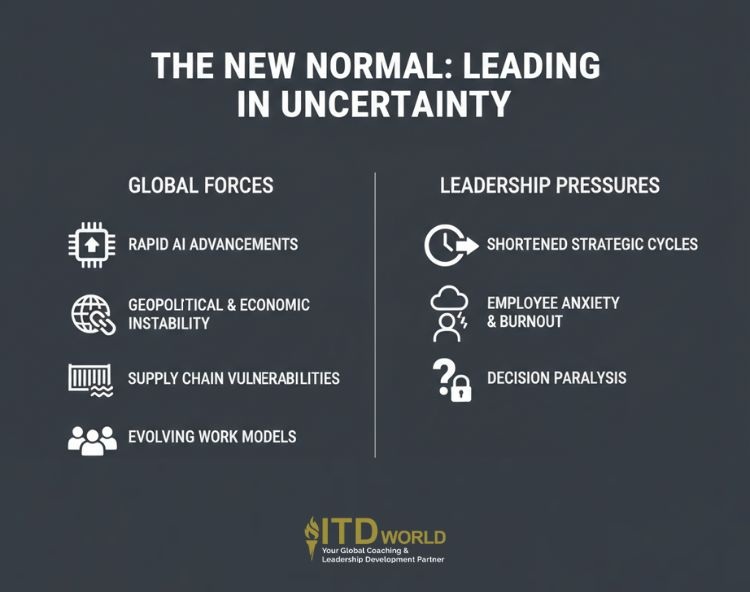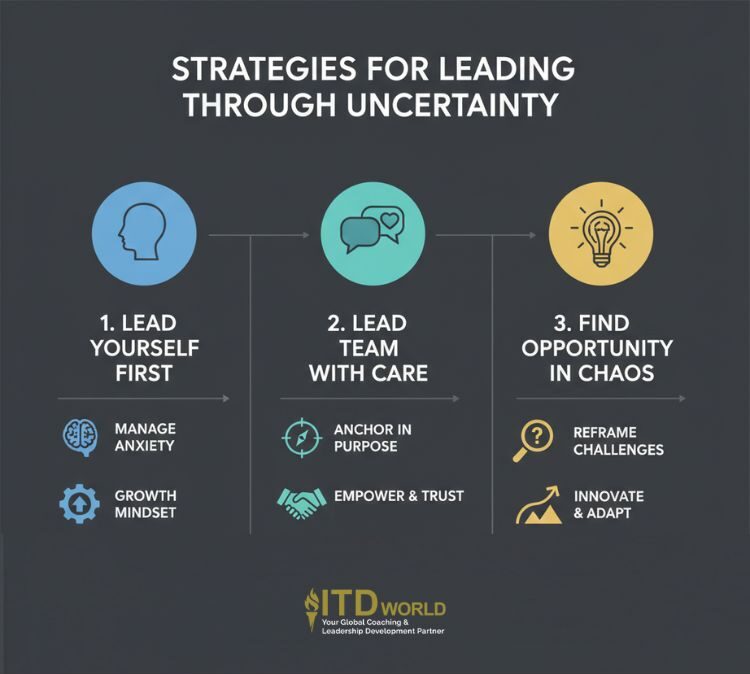Explore the secrets of leading through uncertainty, including the specific qualities & steps leaders can take to navigate challenging times.
Leading a team in today’s world often feels like navigating through a dense fog, where the path ahead is unclear and familiar landmarks have disappeared. In these conditions, a leader’s most important function is not to pretend they have a perfect map – but to serve as a reliable compass for their team. Leading through uncertainty is the essential skill of providing direction, purpose, and psychological safety, even when the future is unknown, thereby building a resilient and agile crew capable of moving forward with confidence.
|
Author: Jonathan M. Pham |
Highlights
- In today’s business world, leadership faces unprecedented challenges due to a persistent state of uncertainty driven by rapid AI advancements, geopolitical and economic instability, supply chain vulnerabilities, and evolving work models, leading to shortened strategic cycles, increased employee anxiety, and decision paralysis, ultimately requiring a new, adaptable approach to leadership.
- In challenging times, a leader’s role shifts from optimizing tasks to managing meaning and emotion, acting as a “Chief Sense-Maker” to provide clarity and psychological safety, and serving as a stabilizing force rather than an anxiety amplifier to foster trust and enable problem-solving.
- Effective leadership in uncertain times requires a disciplined approach, beginning with self-mastery to manage anxiety and build resilience, followed by leading the team with transparent communication, psychological safety, and a focus on purpose and short-term wins, and finally, by identifying opportunities within the chaos.
The New Normal: Leading in an Age of Constant Uncertainty
The feeling of navigating through a dense fog is no longer a temporary condition; it has become the persistent climate of the modern business world. The current state of pervasive uncertainty (some refer to it as a “permacrisis”) is not caused by a single event – but by the convergence of several global forces:
- Rapid AI advancements: Artificial intelligence is reshaping entire industries, automating tasks, and demanding a rapid upskilling of the workforce in uniquely human capabilities like critical thinking and creativity.
- Geopolitical & economic instability: Shifting global alliances, trade policies, and economic volatility all contribute to an unpredictable environment for businesses, impacting everything from market access to currency fluctuations.
- Supply chain vulnerabilities: The interconnectedness of the global economy means that a disruption in one part of the world – whether from a health crisis, a natural disaster, or a conflict – can cause immediate and far-reaching consequences on supply and operations worldwide.
- Evolving work models: The post-pandemic shift toward hybrid work and a greater focus on employee well-being has fundamentally changed the social contract between employers and employees, requiring new approaches to engagement and culture.

Leading through uncertainty
These above mentioned macro trends create specific and tangible pressures on organizations, making leadership more challenging than ever before.
- Shortened strategic cycles: The traditional five-year strategic plan is becoming increasingly obsolete. As noted by sources like McKinsey & Company, the pace of change now requires organizations to adopt more agile, shorter-term strategic planning cycles to adapt effectively to new information and market shifts.
- Increased employee anxiety and burnout: Constant disruption and a lack of predictability take a heavy toll on the workforce. Gallup’s “State of the Global Workplace” reports have consistently shown that employee stress remains at record-high levels. In an uncertain world, employees look to their leaders for a sense of stability and psychological safety, and when that is absent, burnout and disengagement follow.
- Decision paralysis: Faced with overwhelming complexity and incomplete information, leaders are likely to fall into a state of “analysis paralysis.” The fear of making the wrong move leads to inaction, causing the organization to stagnate while more agile competitors move forward.
The current reality demands a new kind of leadership – one equipped not with a perfect map, but with a reliable compass.
Read more: Business Process Transformation – Strategies for Success

The Role of Leadership in Uncertain Times
In a stable and predictable environment, a leader’s role typically centers on optimizing processes/ tasks and driving efficiency. However, in the persistent fog of uncertainty, their function undergoes a fundamental transformation – what they need to be concerned about is not just the work, but the meaning and emotion surrounding it.
The core mandate: Managing meaning, not just tasks
When external circumstances are chaotic, a leader’s most crucial job is to create internal clarity, purpose, and psychological safety for their team. Their focus must shift from the “what” to the “how” and the “why”:
- How is the team feeling and coping with the pressure?
- Why does their work still matter in the face of this new reality?
In this sense, the leader becomes the “Chief Sense-Maker” for their team. They must absorb the complexity and noise of the outside world and translate it into a coherent narrative and a clear set of immediate priorities. Their role is to provide the context that allows their team to feel grounded and focused, even when the broader landscape is shifting.
The two paths: Anxiety amplifier vs. Stabilizing force
In a crisis or a period of high uncertainty, a leader’s emotional state is contagious. They will inevitably become one of two things for their team:
- The anxiety amplifier: Such leaders mirror the external chaos. They react emotionally to bad news, forward frantic late-night emails, and constantly shift priorities based on the latest headline.
Example: After a competitor announces a new product, the Anxiety Amplifier calls an emergency meeting, expresses alarm, and demands an immediate, reactive change in strategy, leaving the team feeling panicked and insecure. Their approach breeds confusion and fuels burnout.
- The stabilizing force: This leader acts as a “shock absorber” for their team. They acknowledge external challenges calmly, remain deliberate in their response, and project confidence in their team’s ability to navigate the situation.
Example: After the same competitor announcement, the Stabilizing Force calls a team meeting and says, “I’ve seen the announcement, and it’s an interesting move. It doesn’t change our long-term vision, but it’s something we need to analyze carefully. I want us to spend this week analyzing their product and preparing a measured, strategic response. I have full confidence in our ability to handle this.” Their response promotes trust and empowers the team to focus on proactive problem-solving.
In times of uncertainty, a leader’s most critical contribution is not always having the right answer, but creating the psychological and emotional stability that allows their team to find the right answer together.

Leading through the unknown
Strategies for Leading Through Uncertainty
Becoming a “stabilizing force” for your team is not a personality trait one is born with; it is the outcome of a disciplined and intentional approach to leadership. In the face of uncertainty, effective leaders follow a clear playbook that builds upon itself: they first lead themselves, then they lead their team with purpose, and finally, they learn to find the opportunity hidden within the chaos.
-
Lead yourself first: Master your inner game
You cannot project calm and confidence to your team if you do not cultivate it internally. The ability to lead others through uncertainty begins with your own personal resilience and mindset.
- Manage your own anxiety: Leaders are not immune to stress, but they must be disciplined about how they process it. This means having your own outlets – whether it’s a mindfulness practice, exercise, or a confidential partnership with a coach or mentor – to manage your own anxiety so you don’t pass it on to your team.
- Embrace a growth mindset: It is essential that you view the uncertainty not as a threat to be endured, but as a complex problem to be solved – and an opportunity to learn. Such a mindset shifts the emotional tone from fear to curiosity and empowers you to see possibilities where others only see roadblocks.
- Develop personal resilience: Turbulent times are a marathon, not a sprint. To avoid burnout, you need to be disciplined about self-care – by protecting your sleep, maintaining healthy habits, and setting boundaries to ensure you have the energy required to lead effectively over the long term.
Read more: Leading Through Uncertainty Requires Coaching – by Dr. Marcia Reynolds
-
Lead your team with clarity and care
Once your own mindset is grounded, you can focus on cultivating an environment of stability, safety, and purpose for your team.
- Communicate transparently and frequently: In a vacuum of information, people will assume the worst. The antidote is to over-communicate – by holding regular, short check-in meetings and being honest about what you know, what you don’t know, and what the plan is to find out more. Transparency builds trust far more effectively than projecting false confidence.
- Ensure psychological safety: Create a space where team members feel safe to voice concerns, admit they are struggling, or suggest a risky idea without fear of blame. When people are afraid to speak up, you lose access to the vital on-the-ground information needed to navigate a crisis.
- Anchor the team in purpose and short-term wins: When the long-term path is foggy, anchor your team in two things: their stable, long-term purpose (the “why” behind their work) and achievable short-term goals.
Example: A leader might say, “While the market is unpredictable, our mission to serve our customers hasn’t changed. Let’s focus on one thing we can control: this week, our goal is to successfully resolve all high-priority customer tickets. Let’s nail that.”
- Empower and trust your people: Uncertainty is a time to increase, not decrease, autonomy. Trust your team members to solve the problems that are directly in front of them. Doing so builds their capability and confidence when they need it most.
-
Look for the opportunity in chaos
This is the most advanced leadership practice: moving from a defensive posture of survival to an offensive one of opportunity. Once the immediate crisis is managed, the leader’s role is to reframe the narrative and challenge the team to find the “silver lining” or the new possibilities created by the disruption.
Example: Instead of only asking, “How do we survive this supply chain disruption?”, a resilient leader asks, “Does this disruption create an opportunity for us to find new, more innovative local suppliers that could make us stronger in the long run?” This shifts the team’s energy from fear toward creative, forward-looking problem-solving.
Read more: Leadership Potential – How to Spot & Cultivate Future Leaders

How to deal with uncertainty at work
Challenges of Leading Through Uncertainty
Even with the best playbook, leading through prolonged periods of uncertainty presents unique and demanding challenges that can test the most resilient leaders and teams. Recognizing these specific difficulties and preparing for them is key to maintaining momentum, morale, and effectiveness over the long term.
- Managing heightened team anxiety and burnout
Constant change and a lack of predictability are mentally and emotionally draining. Even with an experienced leader, team members may still suffer from heightened anxiety about the future and are at a high risk of burnout from operating in a sustained “on-alert” state.
Solution: Leaders must become even more vigilant and empathetic, acting as their team’s “Chief Well-being Officer.” In other words, they need to double down on the human element of leadership.
In practice: Shift the focus of your one-on-one check-ins. Instead of starting with “What are you working on?”, start with “How are you holding up?” and genuinely listen to the answer. Additionally, do your best to protect your team from non-essential work to conserve their energy, and make a conscious effort to publicly and frequently celebrate small wins – so as to provide a much-needed sense of progress and boost morale.
- Making high-stakes decisions with incomplete information
Leaders typically feel immense pressure to make the “right” call when the data is ambiguous, the future is unpredictable, and the consequences are significant. This pressure can easily lead to “decision paralysis,” where the fear of making the wrong choice prevents any choice from being made.
Solution: Abandon the quest for the perfect decision and instead adopt an agile, experimental mindset.
In practice: Break down large, irreversible decisions into smaller, safer steps. Frame your actions as experiments designed to gather more data. For example, “We don’t know for sure which new marketing channel will be most effective, so for the next month, we are going to run three small, low-cost experiments. We will measure the results, learn quickly, and make our next move based on that data.” Doing so reduces risk and turns uncertainty into a source of learning.
- Keeping remote and hybrid teams aligned and connected
Uncertainty is amplified when teams are physically dispersed. It is easier for misinformation and rumors to spread, for team members to feel isolated, and for strategic alignment to drift when the informal, in-person interactions that build cohesion are reduced.
Solution: Leaders of distributed teams must be radically intentional about communication and connection.
In practice: Replace spontaneous office conversations with structured connection points. For example, one may implement daily 15-minute “huddles” on video call to ensure everyone is aligned on the day’s top priorities. They can also leverage technology to foster social connection, such as creating a non-work-related team chat channel for informal conversation or scheduling short, optional virtual “coffee breaks” to maintain the personal rapport crucial for trust.
Read more: Change Management – How to Champion It
Leading Through Uncertainty Quotes
Uncertainty is the only certainty there is, and knowing how to live with insecurity is the only security.
John Allen Paulos
The ultimate measure of a man is not where he stands in moments of comfort and convenience, but where he stands at times of challenge and controversy.
Martin Luther King Jr.
If you’re going through hell, keep going.
Winston Churchill
Uncertainty is an uncomfortable position. But certainty is a ridiculous one.
Voltaire
A leader takes people where they want to go. A great leader takes people where they don’t necessarily want to go, but ought to be.
Rosalynn Carter
Take a method and try it. If it fails, admit it frankly, and try another. But by all means, try something.
Franklin D. Roosevelt
Maturity is the capacity to endure uncertainty.
John Huston Finley
If uncertainty is unacceptable to you, it turns into fear. If it is perfectly acceptable, it turns into increased aliveness, alertness, and creativity.
Eckhart Tolle
Without the element of uncertainty, the bringing off of even, the greatest business triumph would be dull, routine, and eminently unsatisfying.
J. Paul Getty
In crisis management, be quick with the facts and slow with the blame.
Leonard Saffir
The true test of leadership is how well you function in a crisis.

Leading through ambiguity
Leading Through Uncertainty Books
- Leading Through Uncertainty by Jude Jennison
This book blends emotional intelligence with practical leadership strategies. Jennison draws on her unique experience working with horses to explore non-verbal communication, emotional resilience, and human connection in high-pressure environments. The second edition, updated for the post-pandemic world, presents insights from interviews with leaders navigating disruptive change.
- Leadership in Turbulent Times by Doris Kearns Goodwin
A masterful historical analysis, the book profiles four U.S. presidents – Lincoln, Theodore Roosevelt, FDR, and LBJ – highlighting how they led through personal and national crises. It’s a compelling reminder that uncertainty has always been a crucible for great leadership.
- The Obstacle Is the Way by Ryan Holiday
Rooted in Stoic philosophy, Holiday’s publication deals with the theme of turning adversity into advantage. He uses historical examples to show how embracing uncertainty and obstacles is key to growth and innovation.
- The Fearless Organization by Amy C. Edmondson
With a focus on psychological safety, this book is essential for leaders who want to foster open communication and innovation during uncertain times. Within her work, Edmondson emphasizes that teams thrive when people feel safe to speak up – even when the future is unclear.
- Dare to Lead by Brené Brown
Brown brings her signature blend of vulnerability and research to leadership. She argues that courage, empathy, and connection are the antidotes to fear and uncertainty in the workplace.
Read more: Leadership Philosophy – How to Define Your True North & Follow It
Discover ITD World’s Leadership Training Solutions for a VUCA World
In an uncertain world, the only true certainty is the capability of your leaders. Investing in their resilience is investing in that of your entire organization.
At ITD World, we specialize in equipping leaders and organizations with the specific skills and mindsets needed to thrive in a Volatile, Uncertain, Complex, and Ambiguous (VUCA) world. Our programs are designed to move beyond theory and provide the practical tools to lead with confidence and purpose, no matter the challenge.
We offer a range of solutions to build your organization’s resilience:
- Leadership development workshops: These programs are designed for participants to master their “inner game” through the use of practical tools for managing stress, adapting to rapid change, and cultivating the positive, forward-looking mindset necessary to lead effectively through turbulence.
- Change management programs: We equip your leaders with the frameworks to guide their teams through disruption. Our programs focus on how to communicate change effectively, manage resistance with empathy, and maintain team morale and productivity during uncertain transitions.
- Executive coaching: We provide a confidential, one-on-one partnership for leaders navigating their unique, high-stakes challenges. Our expert coaches serve as a strategic sounding board, helping leaders make difficult decisions with clarity and strengthen their personal resilience.
- Customized “Leading in a VUCA World” solutions: For organizations committed to building an enterprise-wide capability, we partner with you to design bespoke programs that create a shared language and a consistent approach to navigating uncertainty across your entire senior leadership team.
Ready to equip your leaders with the tools and mindset to not just survive, but thrive in challenging times? Contact ITD World today to learn how our solutions can help!
Other resources you might be interested in:
- Leadership Development: A Mission-critical Strategic Function
- Influential Leadership: Influence to Inspire, Lead, and Succeed
- Weak Leadership: How Bad Leaders Undermine Success
- Future Ready Organization: 11 Tips to Building One Capable of Adapting to Industry Trends
- Ego in the Workplace: The Hidden ‘Evil’ Behind Team Dysfunctions

